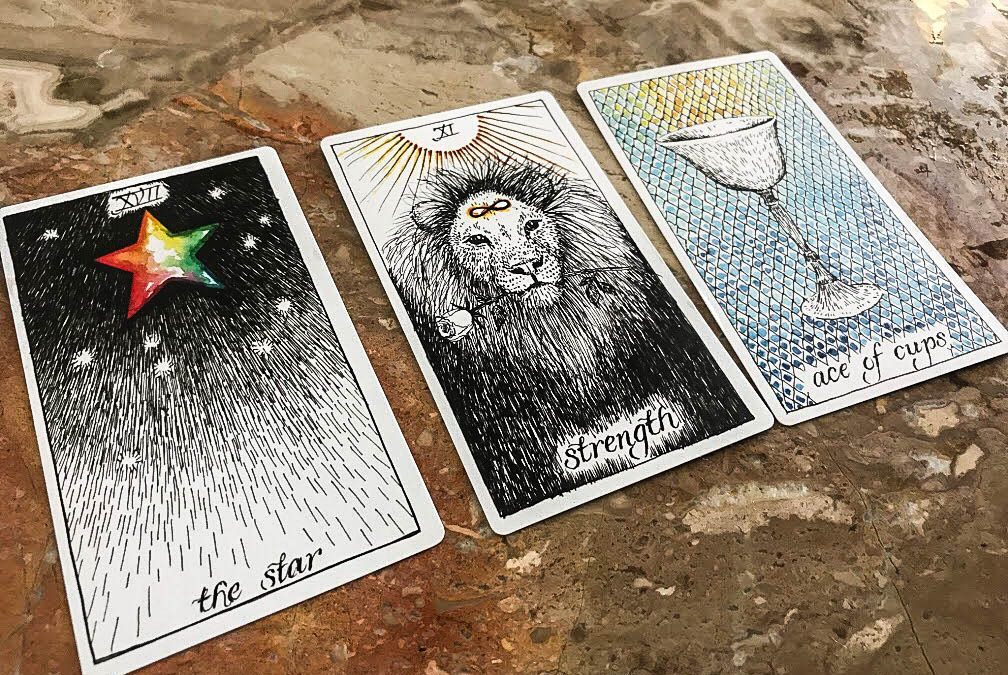Tarot is often thought of as a vessel for future-telling, though this limits the possibility of tarot reading. The tarot offers an abundance of potential writing exercises for anyone—you needn’t be a high priestess, brooding hermit, or occult enthusiast of W.B. Yeats proportions to begin a tarot practice for creative inspiration and organization.
Ritual, magic, and intuition have become hot topics in the literary world. Jessa Crispin’s book The Creative Tarot: A Modern Guide To An Inspired Life details lessons artists can learn from the cards. Writers the likes of Michelle Tea (author of the queer-coming-of-age memoir Valencia) have even penned their own tarot handbooks.
“The Tarot is an ancient story system,” Tea writes, “a pack of cards that tell a multitude of tales depending on the ways in which they’re placed alongside on another.”
Still not confident in your ability to join in the fun? You can find free tarot reading resources on websites like Biddy Tarot that can help you begin your journey.
As the literary tarot community continues to grow, let’s join in and try our hand at tarot-inspired creative writing exercises. These exercises are meant to be adaptable to all genres of writing, though you may feel free to adapt them to your writing style as needed.
(These exercises will require a tarot deck—if one is inaccessible to you, my creative challenge is to create your own—either alone or even as a collaboration!)
- Oracular Persona
Draw a single card from your deck. If the drawn card depicts a human, free write a character description based on who is depicted. What are they doing, and why are they doing it? Where did they get the clothes they’re wearing? What troubles and joys live behind them now, and do they know where they’re going next? What secrets do they keep? Where are they kept?
If the card does not include a humanoid figure and simply an object or structure, challenge yourself to decipher the object’s motives and personality as well.
Write a 10 item list, then write a page of action centering your new character. Poets, write a persona poem based on your card.
Research and reflect on the meaning of the chosen card. Are there emotional or symbolic significances you could incorporate in the next draft?
- Self-Portrait in Tableau
Draw a card from the deck. Observe the depicted landscape, environment, or architecture. What’s in the foreground, the background? What gathers in corners, what clouds gather at the horizon? Does the landscape imbue you with openness or claustrophobia? What colors are prominent?
Next, write yourself into the landscape. Do you have a feeling of belonging or alienation? Why are you there? Are you safe? What have you explored, and what is new to you? Have you been someplace like this before? In real life or in a dream? Use this free write to jumpstart a scene, essay, or poem.
- Querent and Creator
The literary magazine Winter Tangerine included this exercise for their 2018 National Poetry Month exercises—write a poem where you create a new tarot card. This is a terrific exercise for those who don’t yet have a deck.
Further questions to consider for this exercise—what rituals are important to the card, and how did you come to learn them? What ancestral knowledge informs the card? Why do you choose these certain colors? What happens when the card is drawn reversed? Is the card a call to action or quiet reflection?
Bonus twist: write an imagining of this card being drawn for someone once important in your life who is now absent.
Tarot-curious after this post, but don’t have a deck of your own yet? There are as many tarot decks as there are sub-genres of literature. Check out the autonomic deck, accompanied by the creator’s experimental novella and tarot handbook To Run Wild With It. Take your time to find the deck that’s right for you. What speaks to your own experience and writing?
For further divination inspiration, check out Little Red Tarot for more ways to incorporate tarot reading into your daily life and practices.
Happy reading!
Meet the blogger:
 HALEE KIRKWOOD is pursuing an MFA at Hamline University in Saint Paul, Minnesota, and is a descendant of the Fond du Lac Band of Lake Superior Ojibwe. Their work has been published or is forthcoming in Muzzle Magazine, Cream City Review, Midwest Gothic, and others. Kirkwood is current associate editor for Runestone and was selected as a teaching fellow for the 2019 Desert Nights, Rising Stars writing conference at Arizona State University.
HALEE KIRKWOOD is pursuing an MFA at Hamline University in Saint Paul, Minnesota, and is a descendant of the Fond du Lac Band of Lake Superior Ojibwe. Their work has been published or is forthcoming in Muzzle Magazine, Cream City Review, Midwest Gothic, and others. Kirkwood is current associate editor for Runestone and was selected as a teaching fellow for the 2019 Desert Nights, Rising Stars writing conference at Arizona State University.


